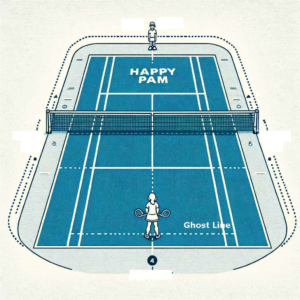HAPPY PAM
In the world of tennis, getting around the court to hit the ball just right involves a lot of different moves. Even tennis superstars like Nadal find it way tougher to scoot backwards than to dash forwards.
And let’s be real, backpedaling in tennis is a bit of a no-no. You end up off-balance, your head’s all over the place, and keeping an eye on the ball? Forget about it! Errors mount quickly, your confidence evaporates!!
Enter the “Happy Pam” position, a smarter way of playing that really gets you thinking about setting yourself up just right, especially when you’re hanging out at the baseline in rallies or returning serve. It’s all about staying ready and keeping your rhythm under pressure.
Let’s break down what makes the “Happy Pam” vibe so cool:
1. Playing Smart: At the heart of the “Happy Pam” style is this idea of staying one step ahead. Instead of reacting to where the ball’s been hit, you’re already figuring out where it’s going and moving to meet it head-on. This means you’re always ready to prepare your ground strokes early with time to spare.
2. Finding Your Sweet Spot at the Baseline: Kicking things off from a spot where you’re feeling balanced and ready at the baseline is key. The “Happy Pam” way is all about making sure you’re in the best possible spot to hit the rally ball or return a serve.
3. Staying Steady: Keeping your balance is super important in tennis. It’s what helps your shots stay strong and accurate. The “Happy Pam” stance is all about finding that solid base so you can lean into your shots with confidence, helping you play better and dodging those pesky injuries caused by consistently putting your body in awkward positions. (Did anyone mention ‘tennis elbow’!)
4. Skipping the Backward Shuffle: This stance is all about cutting down on those times you find yourself moving back, which usually means you’re on the defensive. Staying on the offensive means stronger shots and less time for your opponent to get the upper hand.
Getting the “Happy Pam” stance down pat means really working on your footwork, staying balanced, and getting into the mindset of always being ready for what’s coming next. It’s a full-on strategy for ruling the baseline rallies, returning serve consistently and keeping the game in your favour.
(C) MUIR TENNIS ACADEMY 2010-2024


